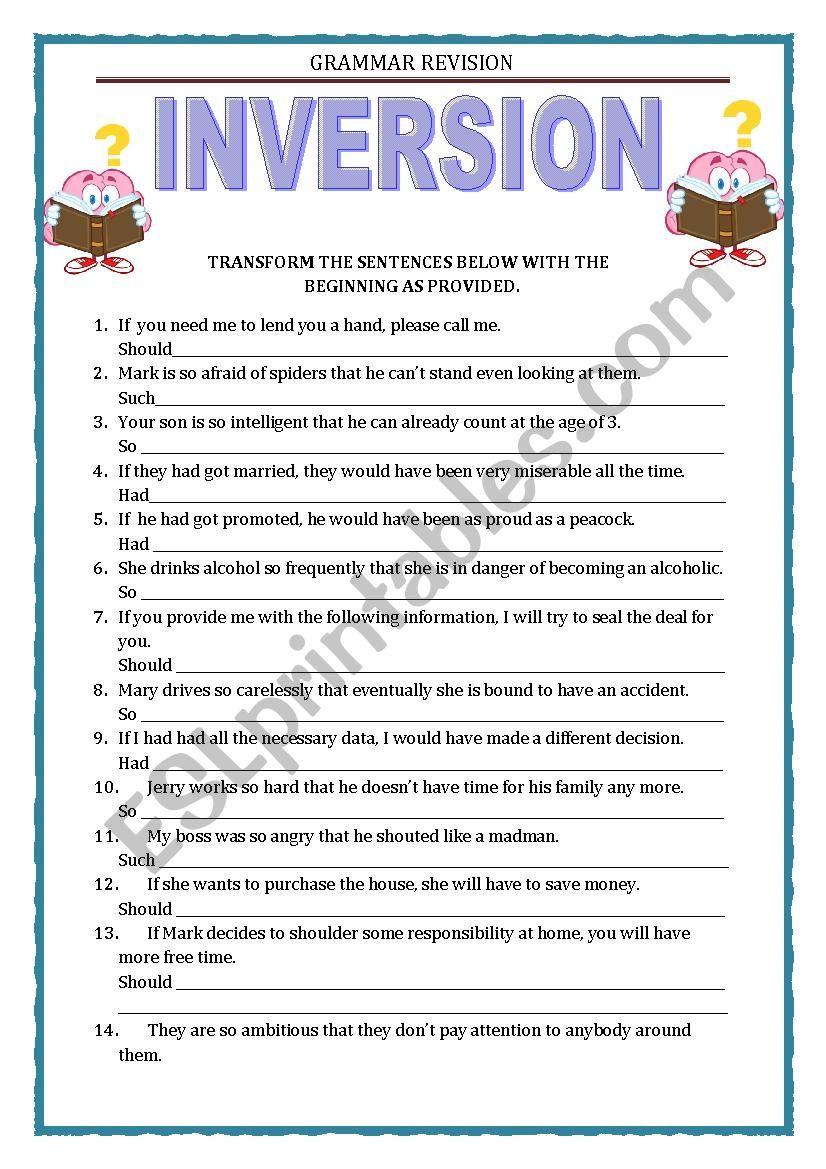
Mastering English Inversion: The Indispensable Role of Inversion Worksheets
English, a language celebrated for its flexibility and vast expressive capacity, often presents learners with fascinating grammatical structures that deviate from the standard subject-verb-object (SVO) order. Among the most elegant yet challenging of these structures is inversion. Inversion, the reversal of the typical subject-verb word order, is not merely a stylistic flourish; it serves crucial grammatical functions, from forming questions to emphasizing certain elements of a sentence. For students aspiring to achieve fluency and a sophisticated command of English, understanding and correctly applying inversion is paramount. This is precisely where inversion worksheets prove to be an invaluable, indeed indispensable, tool.
The Nuance of Inversion: Beyond Simple Questions
At its most basic, inversion is familiar to anyone learning English: it’s how we form questions. For instance, "You are happy" becomes "Are you happy?" This simple subject-auxiliary verb inversion is foundational. However, English inversion extends far beyond interrogative structures, appearing in a variety of contexts that can significantly enhance or alter the meaning and tone of a sentence. These more complex forms of inversion are what often trip up learners and highlight the need for dedicated practice.
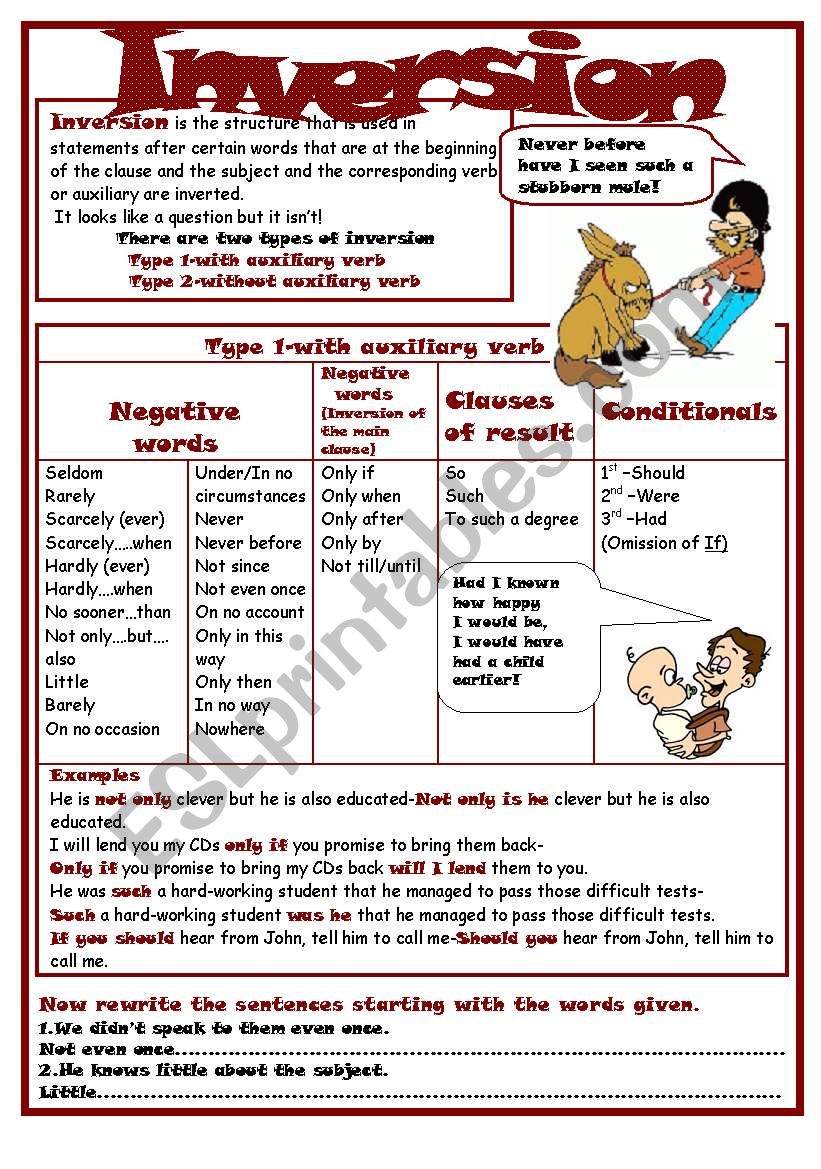
Key instances of inversion include:

-

With Negative Adverbials: When a sentence begins with a negative adverbial phrase, such as never, rarely, seldom, hardly, scarcely, no sooner, not only, little, under no circumstances, in no way, on no account, not until, the auxiliary verb (or ‘do/does/did’) is inverted with the subject.
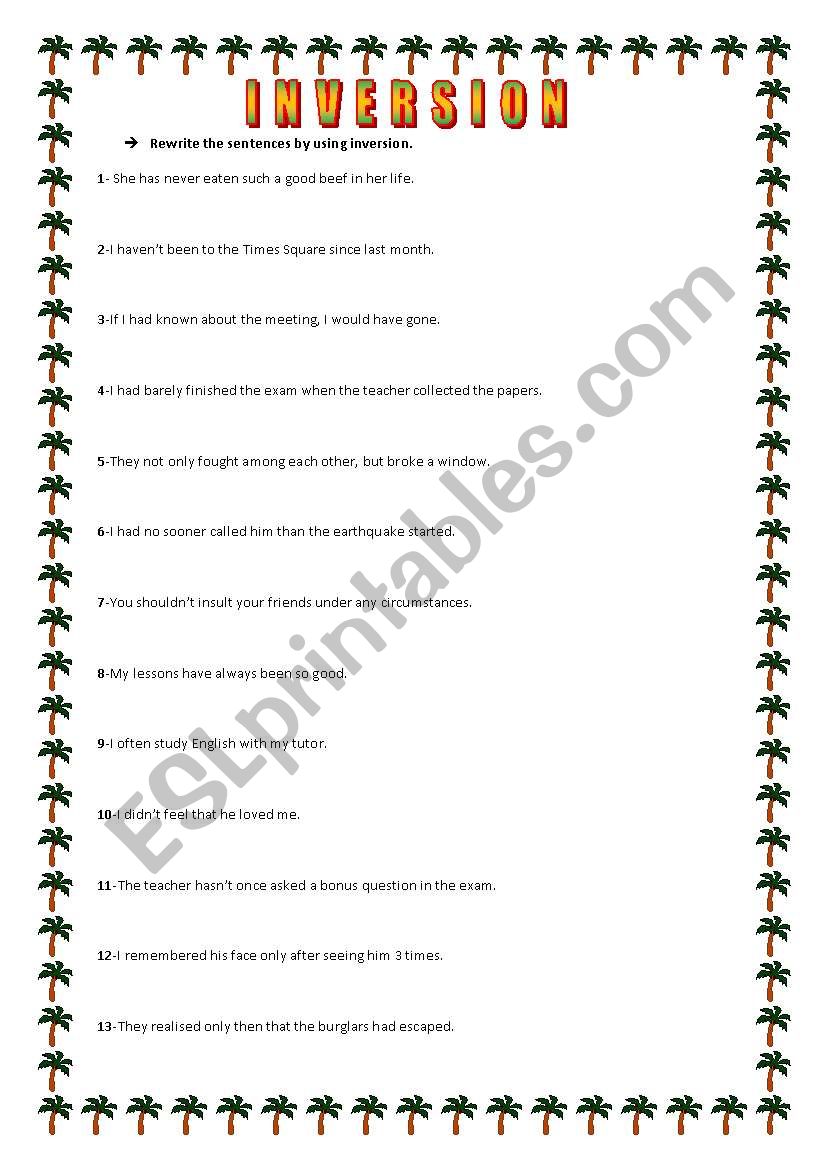
- Example: "I had never seen such beauty." becomes "Never had I seen such beauty."
- Example: "He not only finished the work, but he also helped others." becomes "Not only did he finish the work, but he also helped others."
-
In Conditional Sentences (without ‘if’): In formal English, particularly in Type 1, 2, and 3 conditionals, ‘if’ can be omitted, and inversion occurs.
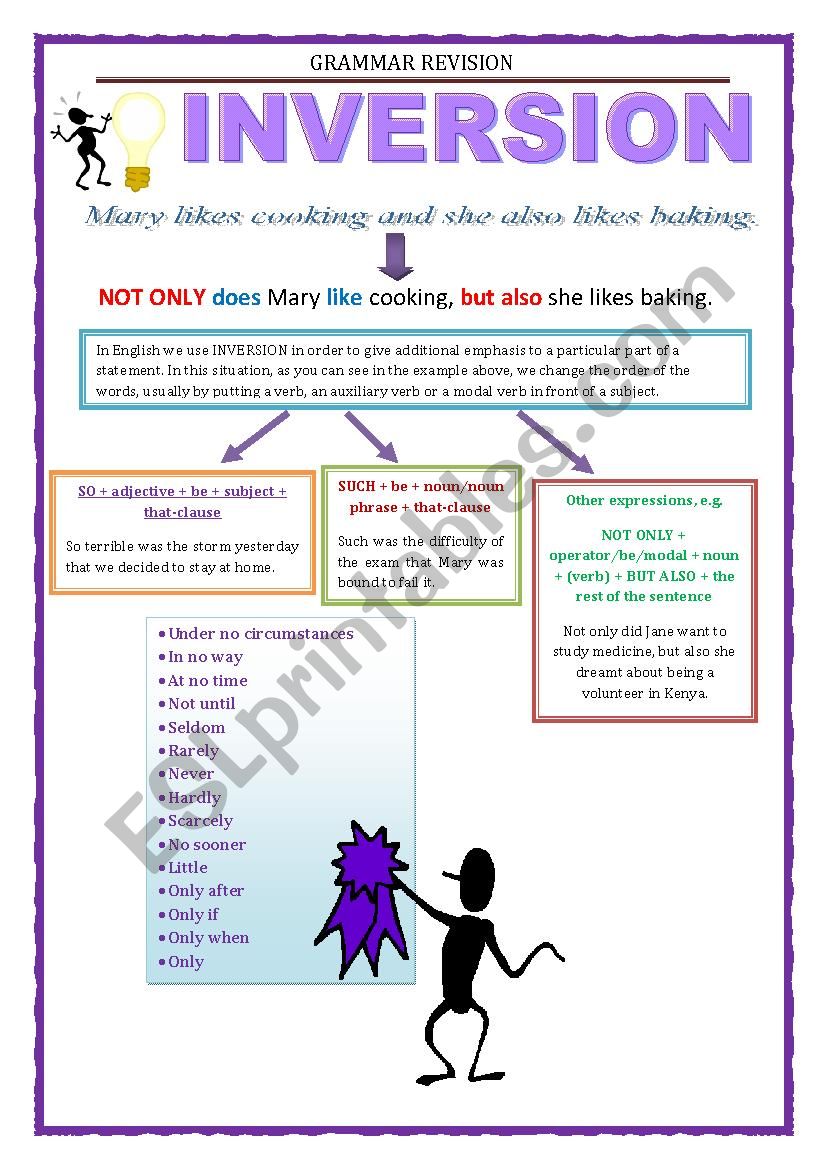
- Example: "If you should need any help…" becomes "Should you need any help…"
- Example: "If I were you…" becomes "Were I you…"
- Example: "If I had known…" becomes "Had I known…"
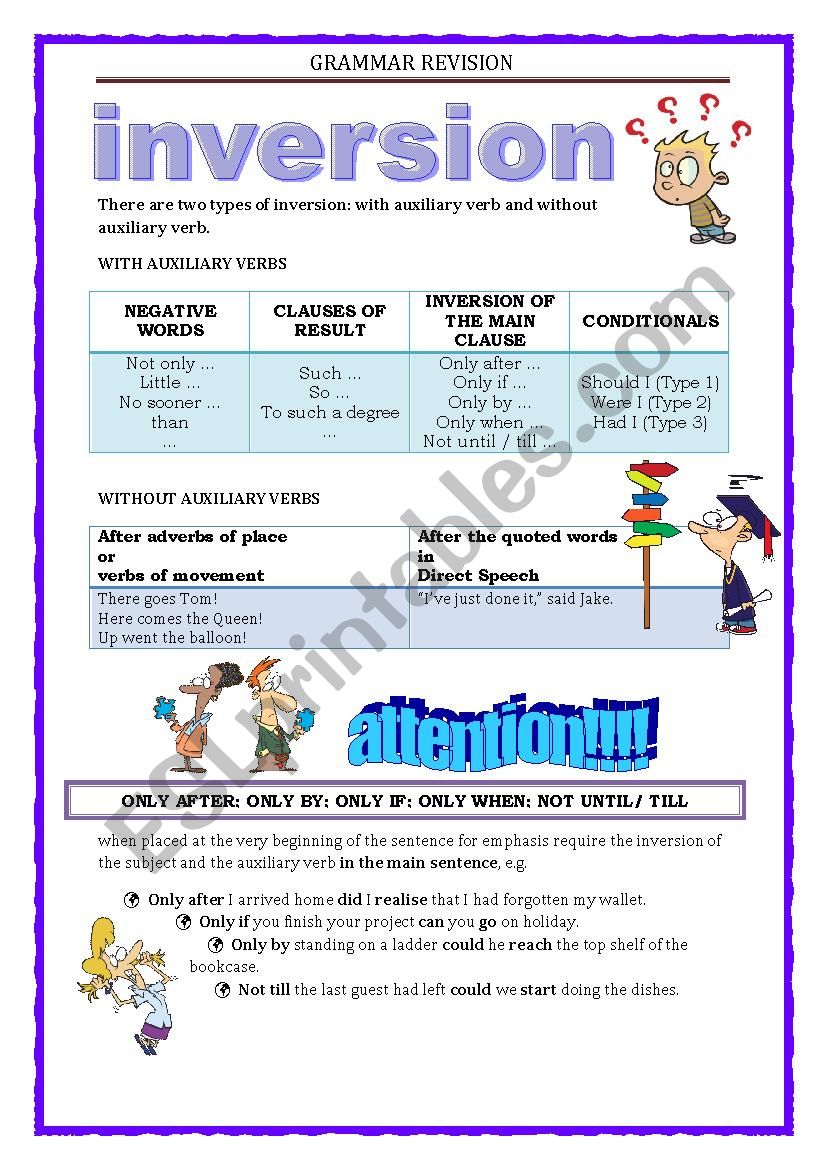
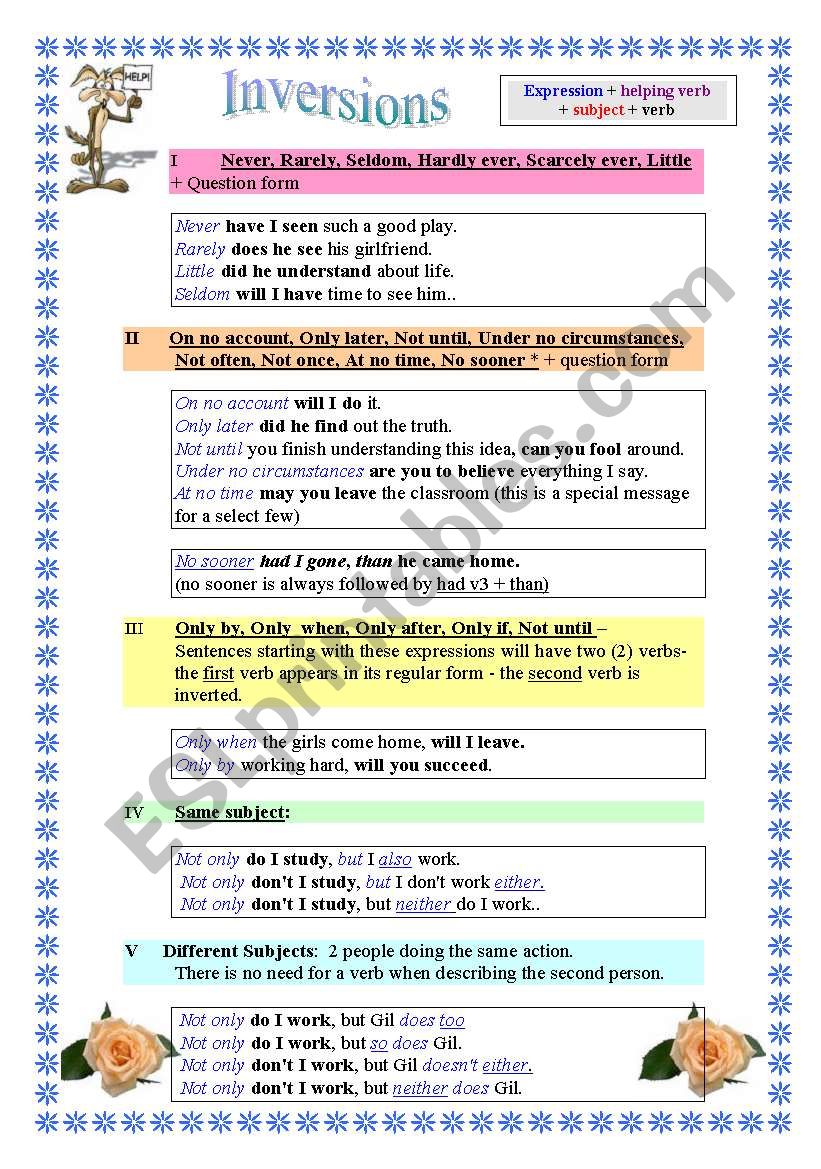
-
After ‘So’ and ‘Neither/Nor’: Used to express agreement with a previous statement.
- Example: "I’m tired." "So am I."
- Example: "He doesn’t like spinach." "Neither do I."
-
With ‘Only’ + Time/Place Adverbial: When ‘only’ precedes an adverbial of time or place at the beginning of a sentence.
- Example: "He realized his mistake only after he left." becomes "Only after he left did he realize his mistake."
- Example: "You can see the stars only in the desert." becomes "Only in the desert can you see the stars."
-
With ‘So/Such…that’: When ‘so’ or ‘such’ introduces a clause at the beginning of a sentence, indicating a cause or reason.
- Example: "He was so tired that he fell asleep." becomes "So tired was he that he fell asleep."
-
After ‘Hardly/Scarcely/No Sooner…than/when’: To describe two events happening in quick succession.
- Example: "I had no sooner arrived than the phone rang." becomes "No sooner had I arrived than the phone rang."


The sheer variety of these rules, coupled with the often subtle nuances in their application, makes inversion a formidable challenge for even advanced English learners. This is precisely why a systematic and repetitive approach to practice is not just helpful but absolutely necessary.
The Indispensable Role of Inversion Worksheets
Given the complexity and multifaceted nature of inversion, learners cannot rely solely on passive exposure or sporadic explanations. Active, targeted practice is key to internalizing these structures. This is where inversion worksheets come into their own as an indispensable pedagogical tool. They provide the structured environment necessary for learners to grapple with the rules, make mistakes, receive feedback, and ultimately, develop an intuitive understanding of inversion.
Here’s why inversion worksheets are so crucial:
-
Targeted Practice: Unlike general grammar exercises, inversion worksheets focus exclusively on this specific grammatical phenomenon. This allows learners to concentrate their efforts, identify patterns, and avoid distraction from other grammatical rules. Each exercise is designed to reinforce a particular rule or a set of rules, ensuring focused learning.
-
Reinforcement of Rules: Repetition is fundamental to language acquisition. Worksheets provide ample opportunities to apply the rules of inversion repeatedly in various contexts. This consistent application helps solidify the rules in the learner’s mind, moving them from conscious effort to automatic usage.
-
Identification of Common Errors: Worksheets often include examples that highlight common pitfalls or exceptions. By working through these, learners become aware of typical mistakes (e.g., forgetting the auxiliary verb, using the wrong auxiliary, or applying inversion where it’s not needed) and learn to avoid them. Error correction exercises are particularly effective in this regard.
-
Exposure to Varied Contexts: A good set of inversion worksheets will present the rules in different sentence structures and scenarios. This ensures that learners don’t just memorize isolated rules but understand how inversion functions in a range of communicative situations, from formal writing to more nuanced conversational English.
-
Building Confidence: Successfully completing challenging inversion exercises builds a learner’s confidence. As they see their accuracy improve, they become more willing to experiment with these structures in their spoken and written English, moving beyond simpler sentence constructions.
-
Preparation for Standardized Tests: Proficiency exams like IELTS, TOEFL, CAE, and CPE often include questions that test a candidate’s knowledge of complex grammatical structures, including inversion. Regular practice with inversion worksheets can significantly improve performance in these sections, demonstrating a higher level of English proficiency.
Types of Exercises Found in Effective Inversion Worksheets
Effective inversion worksheets are not monolithic; they incorporate a variety of exercise types to cater to different learning styles and to reinforce understanding in multiple ways:
-
Sentence Transformation: This is arguably the most common and effective type. Learners are given a standard sentence and asked to rewrite it using inversion.
- Example: "I had never seen such a beautiful sunset." -> "Never before had I seen such a beautiful sunset."
- Example: "If you should have any questions, please ask." -> "Should you have any questions, please ask."
-
Fill-in-the-Blanks: These exercises provide sentences with gaps where the inverted verb or subject needs to be inserted. They often focus on the correct auxiliary verb choice.
- Example: "Not until later ___ he understand the truth." (did)
-
Error Correction: Learners are presented with sentences containing inversion errors and must identify and correct them. This hones their ability to spot subtle mistakes.
- Example: "Scarcely I had arrived when it started to rain." (Incorrect: Scarcely had I arrived…)
-
Multiple Choice: These can test the correct form of inversion among several options, or the appropriate context for its use.
-
Matching Exercises: Pairing a standard sentence with its inverted equivalent, or matching a rule with an example.
-
Contextualized Exercises: Some advanced worksheets embed inversion within short paragraphs, dialogues, or reading passages, requiring learners to identify or apply inversion in a more natural, less isolated context. This helps bridge the gap between mechanical practice and real-world application.
A well-designed series of inversion worksheets will typically progress from simpler forms (like basic question inversion) to more complex and nuanced applications (like those involving negative adverbials or conditional structures without ‘if’). This gradual increase in difficulty ensures a scaffolded learning experience.
Maximizing the Effectiveness of Inversion Worksheets
Simply completing inversion worksheets is not enough. To truly benefit, learners should adopt an active and reflective approach:
- Understand the "Why": Don’t just memorize the correct answer. Understand why a particular inversion is correct and which rule it applies. Refer back to grammar explanations as needed.
- Review Mistakes: Analyze errors carefully. What was the specific mistake? Was it the auxiliary verb? The word order? The trigger word? Learning from mistakes is a powerful way to solidify understanding.
- Practice Regularly: Consistency is key. Short, frequent sessions with inversion worksheets are more effective than infrequent, long ones.
- Combine with Other Resources: Use worksheets in conjunction with grammar textbooks, online tutorials, and authentic English materials (books, articles, films) where inversion might naturally occur. Try to spot inversion in real-world contexts.
- Seek Feedback: If possible, have a teacher or a native speaker review your completed worksheets, especially for more complex sentences.
Conclusion
Inversion is a hallmark of sophisticated English, allowing for emphasis, formality, and a more natural flow in certain contexts. While it presents a significant hurdle for many learners due to its diverse rules and deviation from standard sentence structure, it is a skill that can be mastered with diligent practice. Inversion worksheets are not just supplementary materials; they are fundamental tools that provide the structured, repetitive, and targeted practice essential for internalizing these complex grammatical patterns. By offering varied exercise types, reinforcing rules, and highlighting common errors, these worksheets empower learners to confidently navigate the intricacies of English inversion, ultimately elevating their command of the language to a truly advanced level. For anyone serious about achieving fluency and grammatical precision in English, embracing the consistent use of inversion worksheets is a step that promises significant returns.
